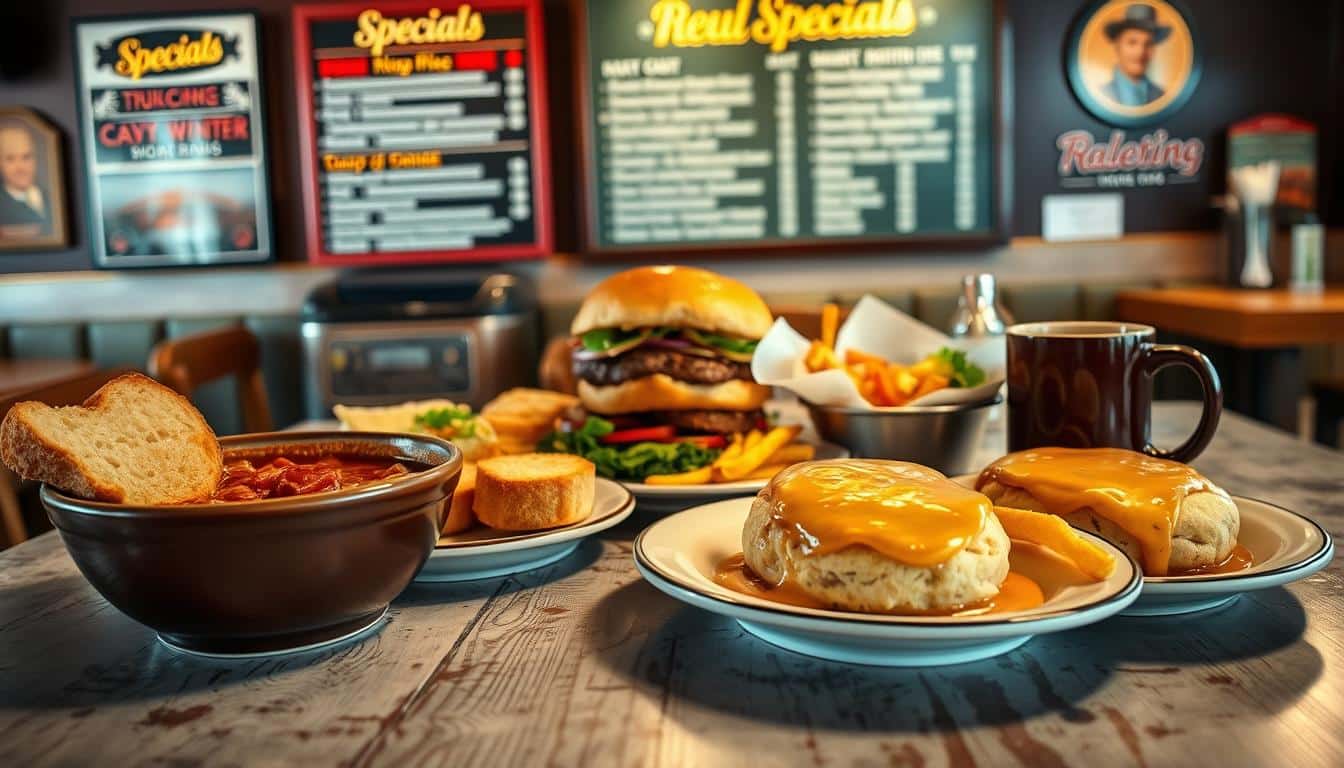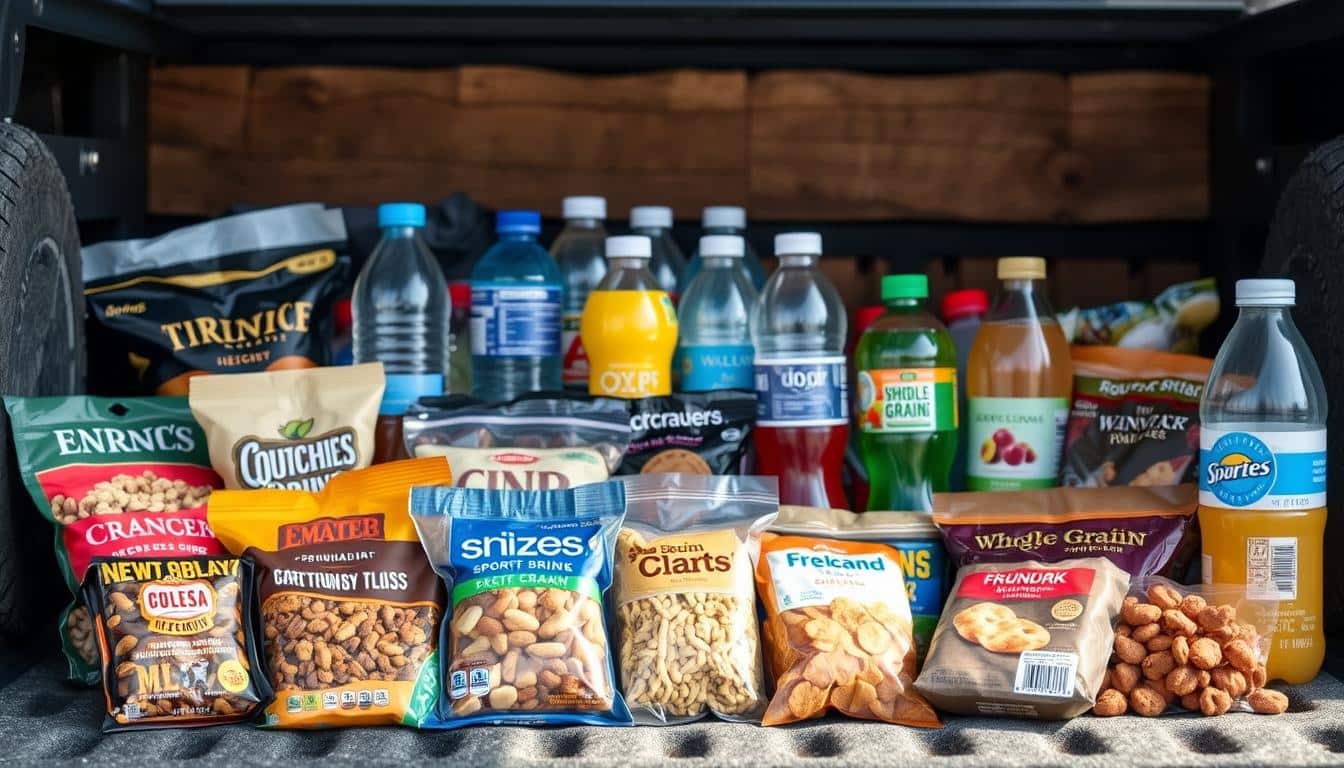Eating well is tough for those always on the road. Truck stops and diners often offer unhealthy options. But with planning, you can eat better by making your own meals. This lets you manage fat, calories, and salt.
Begin with small steps for healthy eating. Start by packing a week’s lunches or some snacks. Or try making a meal that doesn’t need heating, like a wrap or salad. You can use tools like coolers and cookers right in your cab.
Choose meals that fit a busy lifestyle. Options include hard-boiled eggs, quinoa salads, and trail mix. When you have time, make meals like egg bakes or chili. Then, freeze them for later. It’s easy to heat and eat.
Nutrition is key for truck drivers, affecting safety and how well you do your job. Drinking enough water and cutting down on sugar is important. Some companies are encouraging healthier habits. This shows industry support for well-being.
Begin with simple changes, and keep at it. Think of meal prep as a way to save money and stay healthy. It also helps you avoid health problems that truckers often face.
Why nutrition matters for truck drivers
Long trips make eating well hard. Drivers often face limited fresh food choices. Instead, they eat high-calorie, high-sodium meals from truck stops. This habit increases health risks for truck drivers. So, planning meals is key for life on the road.
Health risks linked to poor diet on the road
Poor food choices can lead to overweight and obesity in truckers. Despite sitting all day, many truck drivers consume more calories than they use. Eating too much leads to weight gain and high blood pressure.
Eating foods high in sugar and starch can hurt your teeth and increase diabetes risk. Foods full of bad fats can raise your chances of heart disease. Also, obesity from poor diet can cause cancer and harm bone health, adding to truck drivers’ health issues.
Performance, safety, and wellbeing impacts
What drivers eat impacts how alert and reactive they are. Eating big meals rich in carbs and not drinking enough water can make drivers sleepy. Being tired and not thinking clearly raises the chance of accidents and mistakes at work.
Eating poorly can shorten a driver’s career and lead to more sick days. However, making better food choices and prepping meals can help. It fights tiredness, reduces chronic disease risks, and boosts life quality in the long run.
Practical meal planning for truck drivers
Planning should be easy to match a trucker’s schedule. Start with planning for one meal or one week to keep things simple. Have a goal for each meal: include a protein, a whole grain, and a vegetable.
This method is handy for truckers on long trips.
Start small and set realistic goals
Start with a simple change. Try packing lunches for three days. This is easier than changing all your meals at once. Portion out snacks to avoid eating too much. Use tools like a calorie calculator to help manage portion sizes.
Create a food list with what to eat and what to avoid. Making your own meals means you control what’s in them. Having clear goals makes it easier to stick to your plan.
Batch prep and simple menus
Batch cooking saves time and adds variety. Cook proteins, like chicken or beef, and pair with quinoa or rice. Add roasted vegetables for complete meals.
- Make bowls: protein + grain + veg, change sauces for new tastes.
- No-heat options: wraps, salads, and sandwiches are quick and easy.
- Hot options: thermos or lunchbox cookers are great for stews and eggs.
Meal prep is flexible for truck drivers. Eggs and vegetables can be used for breakfasts. Cooking in batches means less stress about food while on the road. It helps stay healthy and focused.
Cab-friendly gear and storage solutions
Starting with the right gear is key to keeping meals fresh on the road. Compact tools help you store cold foods, heat soups, and prepare no-heat lunches easily. By making small investments, drivers can reduce their stops at truck-stops. This also allows them to better manage what they eat and how much.
To keep perishables safe, consider a reliable 12-volt cooler or an in-cab truck fridge. Using insulated lunch boxes and airtight containers helps extend the shelf life of your food. For times without a microwave or stove, meals in a thermos are a great choice.
Portable cooking and keeping food fresh
Look for lunchbox cookers, compact slow cookers, and USB or 12-volt hot pots designed for a sleeper cab. These items make it easy to cook chili, stews, and grain bowls without much trouble.
On days when cooking isn’t an option, pack no-heat meals like sandwiches, salads, and pre-boiled eggs. Keeping things cool with insulated bags and ice packs in a 12-volt cooler is key for short trips.
Food safety and shelf life on the road
Truck drivers should always keep perishable foods below 40°F for safety. It’s important to eat the most perishable items first. And throw away anything left out too long.
- Keep cut produce, cooked grains, and proteins in airtight containers.
- For longer trips, pick durable protein sources such as canned tuna, low-sodium jerky, and beans.
- Choose fruits like apples and oranges that stay fresh longer, to minimize waste.
Using thermos meals keeps food hot without needing to reheat. A combination of a truck fridge for fresh items and pantry staples creates flexible and safe eating options for drivers on the road.
Healthy breakfast ideas to start long drives right
Breakfast is essential for long drives and should be easy to make. Choose foods rich in protein and fiber. They help maintain steady blood sugar and high energy. Small tweaks in your diet can greatly benefit your focus, health, and driving schedule.
Start with a quick routine before you hit the road. Pack your breakfast in advance. Keep items like yogurt and eggs cool in a refrigerator or cooler. For hot meals, a thermos works great for oatmeal or scrambled eggs.
Quick, protein-rich breakfasts
- Boiled eggs and almonds are easy and don’t need reheating.
- Greek yogurt with nuts and berries is both filling and nutritious.
- Make mini egg bakes with veggies and ham ahead of time. Reheat them quickly for a hearty meal.
- Oatmeal in a thermos with protein powder or nut butter will keep you going longer.
- Choose low-sugar energy bars with plenty of protein to avoid empty calories.
Grab-and-go and no-heat options
- Breakfast burritos with eggs, black beans, and cheese are great for reheating or eating cold.
- Whole-grain muffins with oats and nuts are perfect for easy snacking.
- Fresh fruits and nuts are durable and provide quick energy and healthy fats.
- Try cottage cheese or string cheese with whole-grain crackers for a quick snack.
- Keep a cooler with boiled eggs, Greek yogurt, and cut fruit for easy snacking on the go.
Egg bakes and oatmeal are good for those who like warm breakfasts. Make them in advance to save time. Choose no-prep, easy-to-carry foods if you’re often in a hurry. This helps you stay energized and ready for the day.
Smart snacks to curb cravings and avoid truck-stop temptations
Long trips challenge self-control. Keeping smart snacks in the cab helps drivers stay away from unhealthy food at truck stops. Planning ahead with portion control, balanced meals, and easy storage retains energy and keeps the mind alert.
Healthy snack packing strategies
Divide snacks into small bags to avoid eating too much. Opt for single-serving chips instead of big bags. Clear containers help you track your snacks and prevent mindless eating.
Use a cooler for foods that spoil like yogurt and hummus. Rotate your stash every week to keep things fresh. Remember to date your packages when you get them ready.
- Mix protein, fat, and fiber to stay full longer.
- Use small portion containers for nuts and trail mix.
- Store jerky and shelf-stable items in a dry area of the cab.
Nutritious snack ideas that travel well
Pick snacks that are good on-the-go and still taste great after hours. Choose veggies like baby carrots and apple slices over fried stuff. They’re great with hummus or nut butter.
Keep a variety of go-to options: hard cheese with crackers, unsweetened nuts, popcorn without sugar, and simple beef or turkey jerky.
- Trail mix: almonds, walnuts, unsweetened dried fruit (portion-controlled).
- Protein: string cheese, beef jerky, chicken sticks for quick protein boosts.
- Fiber: air-popped popcorn, whole-grain crackers, fresh fruit.
- Convenience: hummus packs with veggie sticks, Greek yogurt cups kept cool.
These snacks help truck drivers avoid hunger and stay alert. When picking snacks, read labels to steer clear of added sugars and too much salt. A few smart packing tricks can lead to healthier choices at every meal.
Lunch and dinner strategies for balanced meals on the road
Eating well on long trips is key to safe driving and steady energy. Strive for meals that include lean protein, whole grains, and vegetables. This strategy is great for quick bites at a rest area or more planned meals in your cab.

- Protein bowls are a go-to: choose from grilled chicken, turkey, tofu, or canned tuna. Mix in quinoa or brown rice and some raw or roasted veggies for fiber and color.
- Jar salads and grilled chicken salads are perfect for travel. Put dressing at the bottom, then greens, and proteins last to keep it fresh.
- Opt for lettuce wraps, turkey wraps, and veggie burgers for a sandwich feel with fewer refined carbs. Add hummus or avocado for healthy fats.
- Carry low-sodium soups and stews in a thermos for warm, filling meals. Adding beans or lentils increases fiber to keep you fuller for longer.
Make-ahead meals and slow-cooker recipes
Truckers can make slow cooker dishes on their day off and portion them for the week. Chili, pulled pork, beef stew, and BBQ chicken are good choices. They reheat well. Always opt for low-sodium broth and throw in more veggies to boost nutritional value.
- Store meals in airtight containers for quick, balanced meals at truck stops or rest areas.
- Stir-fries with pre-cut veggies and a bit of low-sodium soy sauce cook quickly. Use a skillet or portable cooker.
- Try protein quesadillas and sushi-style rice wraps for on-the-go meals that require no full kitchen.
- Finish eating two hours before bedtime and take a short walk afterward. It helps with digestion and prevents late-night heaviness.
Plan your meals based on available stores and kitchen access. Using simple meal templates like protein bowls and slow cooker dishes helps stay on track, even with tight schedules. Choosing whole grains over white bread and adding more veggies can make road meals both balanced and enjoyable.
How to shop and choose healthier options on the road
Smart grocery trips help drivers stay awake and full of energy. Make a simple plan for the cab that includes fresh veggies, whole grains, and lean meats. If there’s a fridge in the truck, use it. If not, choose foods that keep well.
Grocery checklist for drivers
Start with a short shopping list truckers can use at stops or stores. Keep this list on your phone or printed out in the cab.
- Fruits: apples, oranges, bananas for longer shelf life.
- Vegetables: pre-washed salad mixes, baby carrots, snap peas.
- Whole grains: brown rice packets, quinoa cups, whole-grain wraps.
- Proteins: canned tuna, grilled chicken packs, low-sodium jerky, Greek yogurt.
- Shelf-stable: canned beans, low-sodium canned stuff, nuts, dried fruits like apricots and dates.
- Snacks: hummus cups, plain popcorn, single-serve nut butter.
These choices help truckers shop healthily and find quick, good-for-you snacks on the job.
Reading labels and avoiding hidden sodium and sugar
Take a minute to look at nutrition facts. Pay attention to calories, salt, bad fats, and added sugars. Learning to read these labels makes it easier to avoid secret salts and sweets in packed foods.
- Look for low-sodium labels or options with less than 140 mg per serving.
- Limit added sugars, particularly in sauces and flavored yogurts.
- Be mindful of portion sizes since packaged servings might be smaller than expected.
- Go for whole ingredients. Shorter ingredient lists are usually better.
Stay away from sugary drinks and big, ready-made meals that are high in calories. Set a daily calorie limit to help control eating while on the road.
Hydration and beverage choices for truck drivers
Staying hydrated is key for truck drivers on long trips. Always choose water and keep it within reach. With an insulated bottle, your water stays cold for hours. To improve the taste, add lemon or lime instead of sugary drinks.

Why water matters
Hydration boosts focus, helps your stomach, and keeps joints working right. For truckers, this means safer driving without having to stop as much. A quick way to check if you’re drinking enough is by the color of your pee: pale yellow is good.
But water does more. It controls your body heat and helps your body recover, especially after heavy lifting or getting into the truck.
Healthier alternatives to soda and excess coffee
Instead of sugary drinks, try unsweetened iced tea, diluted juice, or protein shakes with little sugar. These choices provide taste and health benefits for drivers on the move.
Enjoy less soda and coffee to avoid health issues like bone weakness and poor sleep. Plan your stops around your drinking to avoid the need to stop too often. Always keep a refillable bottle close to dodge sugary temptations at truck stops.
- Carry an insulated bottle and refill at truck stops or rest areas.
- Flavor water with citrus or cucumber; skip syrups and sugary mixes.
- Prepare protein drinks or low-sugar smoothies at home to bring along.
- Watch caffeine intake; use tea or a single cup of coffee instead of multiple energy drinks.
Practical lifestyle tips: portion control, labels, and activity
Small changes lead to big results on the road. By packing food in easy-to-eat portions, sticking to a flexible eating plan, and choosing snacks wisely, drivers can maintain regular meal times. This helps avoid the lure of fast food at truck stops.
Portion control and meal timing
Place food in containers or ziplock bags to eat only what you’ve planned. This practice aids truck drivers in following their nutritional goals without overeating. It’s smart to eat meals and snacks every three to four hours to keep your energy balanced.
Finish eating big meals at least two hours before going to bed whenever you can.
Label checking and calorie awareness
Always read nutrition facts to understand sodium, sugar, and serving size. Use a simple calorie calculator to figure out what you need, guiding how much to eat. Truckers, mostly sitting all day, should start with around 2,000 calories daily and adjust as needed.
Opt for whole fruits or homemade juices over sugary drinks to reduce extra calories.
Incorporating movement and short exercises
Short walks near your truck or at stops can boost digestion and wakefulness. Include quick exercises like calf raises, squats, and twists to alleviate stiffness. Such easy exercises help with blood flow and managing weight and require no equipment.
- Pack diverse meals to avoid getting tired of the same food.
- Consider thermoses and meals that don’t need heating for more flexibility.
- Keep single servings in sight to avoid snacking too much.
Conclusion
Small changes can lead to big health wins for truck drivers. Having gadgets like 12-volt coolers and lunchbox cookers helps a lot. Plus, habits such as pre-portioning meals, batch cooking, and using simple ingredients lower calories, sodium, and costs. Say goodbye to frequent, pricey truck-stop meals.
Starting small is key to a healthier trucking lifestyle. Pack your meals and always drink plenty of water. It’s important to read food labels and keep portion sizes in check. Also, aim to eat according to your Basic Metabolic Rate (BMR). Combine healthy eating with quick walks or stretches to stay sharp and lessen tiredness. This is crucial for truck drivers to maintain their health and keep their jobs for a long time.
Check out programs from companies like Swift Transportation that help with driver health. Take it one meal at a time, use cab-friendly cooking gear, choose whole foods over processed ones, and drink lots of water. These steps can boost your energy, cut your disease risk, and help you have a longer, healthier career driving.
FAQ
What are simple first steps for healthy meal planning while driving long haul?
Why does nutrition matter for truck drivers?
What health risks are linked to poor diet and sedentary work in trucking?
How does eating affect safety and on-the-road performance?
How can I plan meals when I have unpredictable schedules and deadlines?
What cab-friendly gear is worth investing in?
How do I keep food safe in the cab without a full kitchen?
What are quick, protein-rich breakfast ideas for drivers?
What grab-and-go breakfast choices work when time is tight?
How should I pack snacks to avoid overeating and temptations?
What nutritious snacks travel well in a cab?
How can I build balanced lunches and dinners on the road?
What make-ahead and slow-cooker meals work best for truck drivers?
What should be on a cab-friendly grocery checklist?
How do I read labels to avoid hidden sodium, sugar, and unhealthy fats?
Why is hydration important and how much should I drink on the road?
What are healthier alternatives to soda and heavy coffee consumption?
How should I practice portion control and meal timing while driving?
How can I track calories or estimate daily needs on the road?
What short exercises or movement can I do to offset long sitting periods?
Do carriers or companies offer resources to support healthier driver habits?
Content created with the help of Artificial Intelligence.



